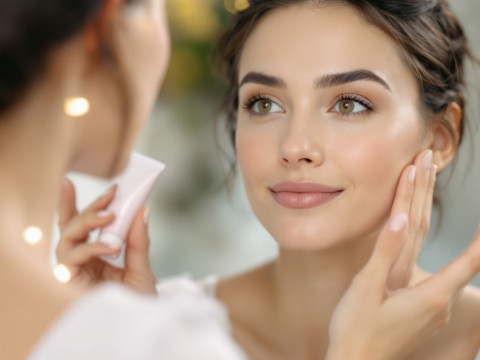So, you’re heading into the field, prepping for some intense duty or just gearing up for regular service life. And you’ve probably realized that military life can really put your skin through the wringer. Let’s face it, with everything from harsh climates to long stretches of demanding activity, skin challenges are just part of the deal—work acne, anyone? But no worries, I’m here to chat with you about keeping your skin in peak condition, military-style.
Understanding the Challenge: Military Life and Your Skin
Imagine this: you’re out on field duty, surrounded by the elements, not to mention the gear you have to carry around. The climate can be extreme—blistering heat, freezing cold, or dry winds—each element seems to conspire against your skin. You’ll find n breacne can really pick up the pace here. This isn’t just a civilian breakout; it’s the type that sets up camp with outdoor skin irritation right by its side. Annoying, right? But with some know-how, you can tackle it head-on.
The Role of Gear and Uniforms
First things first. Let’s talk gear. It’s heavy, it traps heat, and it’s necessary. But guess what? The mighty uniform you’re proud to wear—yep—it’s also a breeding ground for bacteria. Different fabrics rub against your skin constantly, adding friction and sweating, which is a perfect recipe for breakouts and irritation. It’s like giving your acne a military-style boot camp, and it will take that challenge gladly.
Keeping Skin Clean and Clear
Okay, soap and water seem straightforward, right? If only. The key for those in uniform is consistent care amidst consistent chaos. Here’s a basic routine to maintain:

- Cleansing: your first line of defense
- Use a gentle cleanser to wash away dirt, sweat, and grime. Remember, tough isn’t always better—harsh products can aggravate skin and worsen the situation.
- Exfoliation: shedding the old to make way for new
- Weekly exfoliation helps clear dead skin cells that can clog pores. Just be gentle—abrasive exfoliators will do more harm than good, creating small abrasions ripe for infection.
- Hydration: water that saves the day
- Moisturizing sounds like overkill when you’re sweating buckets, but trust me on this one, proper hydration keeps your skin resilient and less prone to breakouts.
When the Sun’s Not Your Friend
Then there’s sun exposure—enemies don’t always carry weapons. Sun damage happens fast when you’re out on operations, and it’s cumulative, too. It doesn’t announce its impact until it’s too late.
- Sunscreen is your silent commissary buddy
- Look for broad-spectrum SPF 30 or higher. Apply generously 30 minutes before stepping outdoors and reapply every two hours. The sun don’t set on this one.
- Hats and protective clothing
- Sunburn isn’t the only issue; there’s sun rash and dryness, too. Ever heard of secondary exposure? Reflective surfaces like snow and water can catch you off guard.
Tactical Solutions to Work Acne
Work acne is a real nuisance; it’s like that mosquito you just can’t catch. Now—don’t give up. These small rank pests can be taken down:

- Spot treatment arsenal
- Salicylic acid or benzoyl peroxide can be your targeted strike team, but apply sparingly. Get a feel for which one hits the target faster.
- Tea tree oil and natural allies
- This potent natural fighter can tackle bacteria head-on. It’s minimizing collateral damage all the while reducing redness. And it’s gentle—just what the skincare officer ordered.
Eating for That Healthy Battle-Ready Glow
Food’s your internal scout; the real “inside job”. What you eat shows on your skin.
- Nourishment through the rations
- A diet rich in fruits, veggies, lean proteins, and whole grains. Omega-3s from fish can curb inflammation, and whole foods maintain your body’s defenses.
- Hydration: Drink like there’s no tomorrow
- Lots of water, minimal caffeine. Key minerals in electrolyte drinks aid recovery after a long day.
Recapping the Battles Worth Fighting
To summarize, military skin protection is about strategy and sustainability. It involves cleansing, genuine skin care, protective measures against the elements, and maintaining internal health through diet—all to keep your defenses strong against work acne.

**Key Takeaways:**
- Consistency is your friend, whether you’re in the barracks or field duty.
- Value your skin under the sun—protection now, fewer regrets later.
- Nutrition plays a tactical role in enhancing skin resilience and reducing acne.
Common Mistakes to Avoid
- Skipping Skincare Routines
- Temptation to prioritize other tasks is high, but a few moments can make a huge difference in the field.
- Using Harsh Products
- Resist the call to arms with too much power. Keep it simple and gentle.
- Ignoring Sun Protection
- A sun streak can follow faster than you think, never underestimate the quiet burn of a routine patrol.
If you assimilate these elements into your daily life, you equip yourself like a pro. Sure, sometimes you’ll slip, equipment press on your shoulder when you’re at your wit’s end. Though remember, a well-run plan and preparation will get you back each time. Skin ready, just like your gear, and clear skies ahead.
Go ahead, give these strategies a whirl, and gear up for military success from inside out!
Frequently Asked Questions
What causes acne, and how does it relate to hormonal changes?
Acne is caused when hair follicles become blocked with oils, dead skin cells, and bacteria. Hormonal changes, particularly the increase in androgens such as testosterone during puberty, pregnancy, or certain medical disorders, can stimulate the sebaceous glands to produce excess sebum, leading to clogged hair follicles and acne[1][3].
What are the common symptoms of acne?
The symptoms of acne include blackheads, whiteheads, papules (tender, raised bumps), pustules (pimples with pus), nodules (solid, painful lumps), and cysts (deep, pus-filled lumps). Affected areas may also show redness, tenderness, and post-inflammatory hyperpigmentation or scarring[1][5].
What are the risk factors for developing acne?
Risk factors for acne include genetic predisposition, high glycemic load diets, endocrine disorders like polycystic ovary syndrome, certain medications such as corticosteroids and anabolic steroids, stress, and the use of certain skin care products that can clog hair follicles[1][3].
How is acne diagnosed, and what role do blood tests play?
Acne is typically diagnosed through a medical history and physical exam. Blood tests may be used to measure hormone levels, such as testosterone, which can be associated with acne. However, a diagnosis can usually be made without blood tests[1].
References










